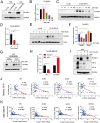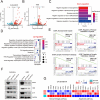This is a preprint.
Plexin D1 emerges as a novel target in the development of neural lineage plasticity in treatment-resistant prostate cancer
- PMID: 38585965
- PMCID: PMC10996809
- DOI: 10.21203/rs.3.rs-4095949/v1
Plexin D1 emerges as a novel target in the development of neural lineage plasticity in treatment-resistant prostate cancer
Update in
-
Plexin D1 emerges as a novel target in the development of neural lineage plasticity in treatment-resistant prostate cancer.Oncogene. 2024 Jul;43(30):2325-2337. doi: 10.1038/s41388-024-03081-6. Epub 2024 Jun 14. Oncogene. 2024. PMID: 38877132 Free PMC article.
Abstract
Treatment-induced neuroendocrine prostate cancer (t-NEPC) often arises from adenocarcinoma via lineage plasticity in response to androgen receptor signaling inhibitors, such as enzalutamide. However, the specific regulators and targets involved in the transition to NEPC are not well understood. Plexin D1 (PLXND1) is a cellular receptor of the semaphorin (SEMA) family that plays important roles in modulating the cytoskeleton and cell adhesion. Here, we found that PLXND1 is highly expressed and positively correlated with neuroendocrine markers in patients with NEPC. High PLXND1 expression is associated with poorer prognosis in prostate cancer patients. Additionally, PLXND1 was upregulated and negatively regulated by androgen receptor signaling in enzalutamide-resistant cells. Knockdown or knockout of PLXND1 inhibit neural lineage pathways, suppressing NEPC cell proliferation, PDX tumor organoid viability, and xenograft tumor growth. Mechanistically, the chaperone protein HSP70 regulates PLXND1 protein stability through degradation, and inhibition of HSP70 decreases PLXND1 expression and NEPC organoid growth. In summary, our findings suggest that PLXND1 could be a new therapeutic target and molecular indicator for NEPC.
Keywords: PlexinD1; Prostate cancer; enzalutamide resistance; neural lineage plasticity.
Figures






Similar articles
-
Plexin D1 emerges as a novel target in the development of neural lineage plasticity in treatment-resistant prostate cancer.Oncogene. 2024 Jul;43(30):2325-2337. doi: 10.1038/s41388-024-03081-6. Epub 2024 Jun 14. Oncogene. 2024. PMID: 38877132 Free PMC article.
-
BET Bromodomain Inhibition Blocks an AR-Repressed, E2F1-Activated Treatment-Emergent Neuroendocrine Prostate Cancer Lineage Plasticity Program.Clin Cancer Res. 2021 Sep 1;27(17):4923-4936. doi: 10.1158/1078-0432.CCR-20-4968. Epub 2021 Jun 18. Clin Cancer Res. 2021. PMID: 34145028 Free PMC article.
-
Activation of neural lineage networks and ARHGEF2 in enzalutamide-resistant and neuroendocrine prostate cancer and association with patient outcomes.Commun Med (Lond). 2022 Sep 21;2:118. doi: 10.1038/s43856-022-00182-9. eCollection 2022. Commun Med (Lond). 2022. PMID: 36159187 Free PMC article.
-
Clinical and Biological Features of Neuroendocrine Prostate Cancer.Curr Oncol Rep. 2021 Jan 12;23(2):15. doi: 10.1007/s11912-020-01003-9. Curr Oncol Rep. 2021. PMID: 33433737 Free PMC article. Review.
-
Therapy considerations in neuroendocrine prostate cancer: what next?Endocr Relat Cancer. 2021 Jul 15;28(8):T67-T78. doi: 10.1530/ERC-21-0140. Endocr Relat Cancer. 2021. PMID: 34111024 Free PMC article. Review.
References
-
- Siegel RL, Miller KD, Fuchs HE, Jemal A. Cancer statistics, 2022. CA Cancer J Clin 2022; 72: 7–33. - PubMed
-
- Saha A, Kolonin MG, DiGiovanni J. Obesity and prostate cancer - microenvironmental roles of adipose tissue. Nat Rev Urol 2023; 20: 579–596. - PubMed
-
- Sternberg CN, Fizazi K, Saad F, Shore ND, De Giorgi U, Penson DF et al. Enzalutamide and Survival in Nonmetastatic, Castration-Resistant Prostate Cancer. N Engl J Med 2020; 382: 2197–2206. - PubMed
Publication types
Grants and funding
LinkOut - more resources
Full Text Sources

